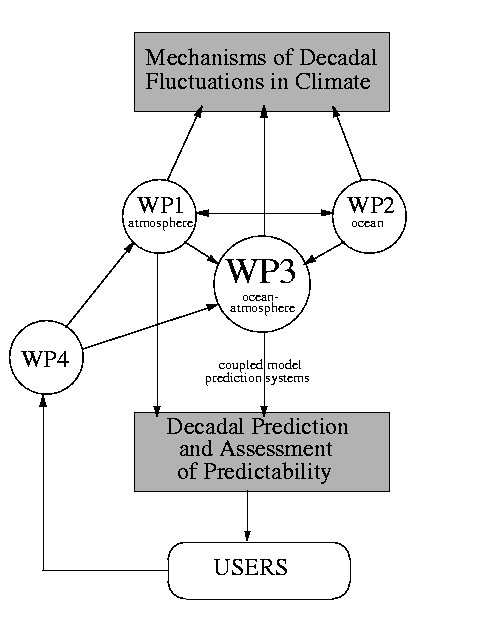
The two goals of this 3-year research programme are (a) to improve
understanding of the processes responsible for decadal-timescale fluctuations
in the climate of the Atlantic-European region, and (b) to assess the extent
to which such fluctuations are predictable. The proposal has been developed
in response to the needs of the European
Union described in the Energy,
environment and sustainable development thematic programme of Framework
5.
European climate exhibits substantial fluctuations on decadal timescales. The North Atlantic Oscillation (NAO) index, which is the most important single index of climate fluctuations in the Atlantic-European sector, has undergone major low frequency fluctuations during the last century, with high values predominating at the beginning and end of the century and low values in the 1950s-1970s. These fluctuations were associated with large anomalies (up to 60% of the mean) in storminess, temperature and rainfall, resulting in major impacts on the peoples and economies of Europe.
Current understanding of the causes of decadal fluctuations in climate is limited. One factor is changes in external forcings of the atmosphere, such as increasing levels of greenhouse gases and variations in solar forcing. Another factor is internal fluctuations within the climate system. For example, interactions between the oceans and the atmosphere are known to be a major cause of climate fluctuations on interannual timescales and may also be the dominant cause of fluctuations on decadal timescales. Progress in understanding how ocean-atmosphere interactions influence decadal fluctuations in climate is urgently needed to improve the detection and attribution of anthropogenic climate change.
Fluctuations in climate are sometimes predictable. In particular, scientists
have made progress in developing systems to forecast interannual fluctuations
such as El
Nino. As reliability improves, these forecasts will be of enormous
value to governments, businesses and individuals. Forecasting decadal fluctuations
in climate is at a much earlier stage of development. The priority at this
time is to establish what level of decadal-timescale predictability exists.
In response to the need for both progress in understanding and assessment
of predictability, this project has five objectives:
PREDICATE involves four workpackages:
WP1: Mechanisms and Predictaility of Decadal Fluctuations in the Atmosphere.
WP2: Mechanisms of Decadal Fluctuations in the Atlantic Ocean
WP3: Decadal Climate Prediction for the Atlantic European Region.
WP4: Project Management, Interactions with Users
and Dissemination of Results.
